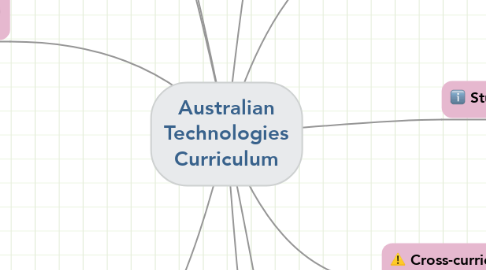
1. Content descriptions
1.1. The knowledge, skills, and understanding for what teachers are expected to teach and students are expected to learn.
2. Content elaborations
2.1. Illustrate the content descriptions to provide further guidance and support for teachers. Student work samples with annotations are being developed to illustrate expectations in the achievement standards.
3. Band levels
3.1. F-2
3.2. 3-4
3.3. 5-6
3.4. 7-8
4. Achievement standards - Link available to Australian Curriculum -->
4.1. F-2
4.1.1. Students describe the purpose of familiar products, services and environments and how they meet a range of present needs. They list the features of technologies that influence design decisions and identify how digital systems are used
4.1.2. Students identify needs, opportunities or problems and describe them. They collect, sort and display familiar data from a range of sources and recognise patterns in data
4.2. 3-4
4.2.1. Describe how social, technical and sustainability factors influence the design of solutions to meet present and future needs. They describe features of technologies that influence design decisions and how a range of digital systems can be used
4.2.2. Students outline and define needs, opportunities or problems. They collect, manipulate and interpret data from a range of sources to support decisions
4.3. 5-6
4.3.1. Explain how social, ethical, technical and sustainability considerations influence the design of solutions to meet a range of present and future needs. They explain how the features of technologies influence design decisions and how digital systems are connected to form networks.
4.3.2. Students describe a range of needs, opportunities or problems and define them in terms of functional requirements. They collect and validate data from a range of sources to assist in making judgements
4.4. 7-8
4.4.1. Explain how social, ethical, technical and sustainability considerations influence the design of innovative and enterprising solutions to meet a range of present and future needs.
4.4.2. Students explain a range of needs, opportunities or problems and define them in terms of functional requirements and constraints. They collect, authenticate and interpret data from a range of sources to assist in making informed judgements
5. Curriculum aims/objectives
5.1. The Australian Curriculum for Technologies aims to develop the knowledge, understanding and skills so that students:
5.1.1. Investigate, design, plan, manage, create and evaluate solutions
5.1.2. Are creative, innovative and enterprising when using traditional, contemporary and emerging technologies, and understand how technologies have developed over time
5.1.3. Make informed and ethical decisions about the role, impact and use of technologies in the economy, environment and society for a sustainable future
5.1.4. Engage confidently with and responsibly select and manipulate appropriate technologies − materials, data, systems, components, tools and equipment − when designing and creating solutions
5.1.5. Critique, analyse and evaluate problems, needs or opportunities to identify and create solutions.
6. Key concepts/ideas
6.1. Overarching idea: Creating preferred futures - provides students with opportunities to consider how solutions that are created now will be used in the future
6.1.1. Project management
6.1.2. Thinking in technologies
6.1.2.1. Systems thinking
6.1.2.2. Design thinking
6.1.2.3. Computational thinking
6.1.3. Information and communication technology
6.1.4. Safety
6.1.5. Animal ethics
7. General capabilities
7.1. Literacy
7.2. Numeracy
7.3. Information and communication technology (ICT) capability
7.4. Critical and creative thinking
7.5. Personal and social capability
7.6. Ethical understanding
7.7. Intercultural understanding
8. Student diversity
8.1. Teachers will use the Australian Curriculum to develop teaching and learning programs that build on students’ interests, strengths, goals and learning needs, and address the cognitive, affective, physical, social and aesthetic needs of all students.
8.1.1. Students with disability
8.1.2. Gifted and talented students
8.1.3. Students for whom EAL/D
9. Cross-curricular priorities
9.1. Aboriginal and Torres Straight Islander histories and cultures
9.2. Asia and Australia's engagement with Asia
9.3. Sustainability
10. Subjects
10.1. Digital technologies
10.1.1. Strands
10.1.1.1. Knowledge and understanding
10.1.1.1.1. Digital systems
10.1.1.1.2. Representation of data
10.1.1.2. Process and production skills
10.1.1.2.1. Investigating and defining
10.1.1.2.2. Generating and designing
10.1.1.2.3. Producing and implementing
10.1.1.2.4. Evaluating
10.1.1.2.5. Collaborating and managing
10.1.1.2.6. Collecting, managing and analyzing data
10.1.1.2.7. Digital implementation
10.2. Design and technologies
10.2.1. Stands
10.2.1.1. Knowledge and understanding
10.2.1.1.1. Technologies and societiy
10.2.1.1.2. Technologies contexts
10.2.1.2. Process and production skills
10.2.1.2.1. Investigating and defining
10.2.1.2.2. Generating and designing
10.2.1.2.3. Producing and implementing
10.2.1.2.4. Evaluating
10.2.1.2.5. Collaborating and managing
